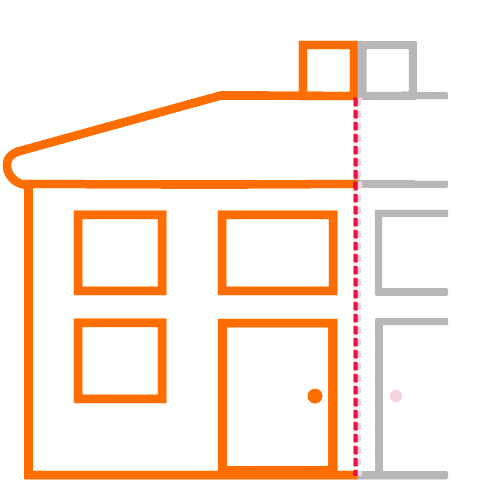To check your loft insulation, you'll need essential tools including a tape measure, flashlight, and protective gear like gloves and a safety mask. Start by measuring the insulation depth across multiple areas, ensuring it meets the recommended minimum of 270mm. Walk only on joists while inspecting for signs of damage such as compression, moisture, or pest activity. Pay special attention to problem areas around recessed lighting, electrical wiring, and wall joints. Consider using thermal imaging or professional assessment for a thorough evaluation. Understanding these inspection basics will help you determine if your insulation needs attention or upgrading.
Tools Required for Inspection
Table of Contents
ToggleFive essential tools are needed to properly inspect your loft insulation.
You'll need a tape measure, which is vital for verifying that your insulation meets the minimum recommended depth of 270mm, ensuring ideal thermal performance throughout your home.
A reliable hand saw will allow you to make precise cuts when fitting insulation boards, maintaining thorough coverage without gaps or inconsistencies.
Given the typically dark conditions in loft spaces, you'll find a flashlight indispensable for conducting thorough inspections, particularly when checking for signs of dampness or deterioration in hard-to-reach areas.
For your safety, you shouldn't overlook proper protective equipment; a safety mask and protective eyewear are essential for guarding against airborne particles and dust that you'll likely encounter during the inspection process.
Finally, you'll want to bring a camera or smartphone to document your findings, as visual records can prove invaluable when consulting with professionals about potential issues or planning future improvements.
These photographic records will help you track changes in your insulation's condition over time and provide clear evidence of any problems that require attention.
Measuring Insulation Depth
With your tools ready, let's focus on the actual measurement process. You'll need to locate the furthest board from your loft hatch and carefully lift it to access the insulation material underneath.
Once you've exposed the insulation, you can begin taking your measurements using a tape measure to determine if it meets the minimum recommended depth of 270mm.
When measuring, verify you're getting an accurate reading by avoiding any compressed areas of the insulation, as these won't provide an accurate representation of the overall depth.
If you find that your insulation falls short of the 270mm standard, you'll want to think about adding additional layers to achieve ideal thermal performance.
While checking the depth, it's vital to pay attention to the space beneath the insulation, confirming there's adequate airflow to prevent condensation issues. Poor ventilation can compromise both the insulation's effectiveness and the structural integrity of your loft space.
Make note of any areas where the insulation appears uneven or particularly thin, as these spots may require additional attention during future improvements.
Safety Precautions During Assessment
Taking proper safety precautions is essential before you begin your loft insulation assessment. You'll need to wear appropriate protective gear, including gloves and safety goggles, which shield your eyes and skin from potentially harmful insulation materials and other hazards you might encounter during the inspection.
When you're moving around the loft space, you'll need to exercise caution by walking only on the joists, as stepping on ceiling boards can result in serious accidents and property damage.
It's vital to check that all electrical wiring remains above the insulation layer, and you should pay particular attention to recessed spotlights, confirming they're properly insulated to prevent fire risks.
While you're conducting your assessment, maintain adequate ventilation in the loft space to minimize the risk of inhaling insulation fibers. You can achieve this by opening any available roof vents or windows before you start the inspection process.
If you're working in a confined space, it's advisable to take regular breaks in fresh air to avoid overheating and guarantee you're maintaining safe working conditions throughout the assessment.
Signs of Damaged Insulation
Now that you're safely equipped and ready to assess your loft, identifying signs of damaged insulation will help you determine if repairs or replacements are needed.
You'll want to carefully examine the insulation's condition, looking for areas where it's been compressed below the standard 270mm thickness, as this compression greatly reduces its effectiveness.
During your inspection, you'll need to watch for moisture-related issues, which often manifest as damp patches or water stains on your ceiling and walls.
These indicators shouldn't be ignored, as they can lead to more severe insulation damage over time.
Look closely for any evidence of pest activity, such as droppings or nesting materials, which can compromise your insulation's integrity.
You should also check for visible deterioration of the insulation material itself, including signs of sagging, brittleness, or holes that might require immediate attention.
Pay particular attention to any areas showing mold growth, as this not only indicates a moisture problem but can also affect your insulation's performance and potentially impact your home's air quality.
If you notice any of these issues, you'll likely need to think about professional assessment and repair.
Common Problem Areas
Several essential areas in your loft require extra attention during an insulation inspection.
You'll need to check for compressed insulation where storage items may have flattened the material, as this greatly reduces its thermal effectiveness. The minimum depth should measure 270mm to maintain proper insulation performance.
When examining your loft, you'll want to look for signs of dampness or condensation beneath the insulation layer, which often indicates underlying issues that require professional assessment before proceeding with any insulation work.
Pay particular attention to recessed spotlights, ensuring they're correctly positioned above the insulation to prevent potential fire hazards.
You'll also need to inspect the edges where insulation meets walls and joints, as gaps in these areas can lead to considerable heat loss and reduced energy efficiency.
Another vital inspection point is the electrical wiring configuration.
Your wiring should run above the insulation layer rather than being trapped within it, as embedded wiring can create dangerous safety risks.
If you notice any of these issues during your inspection, it's advisable to address them promptly to maintain your loft's insulation effectiveness and safety standards.
Professional Assessment Guidelines
While homeowners can perform basic loft inspections, a professional assessment offers a thorough evaluation of your insulation's condition and effectiveness.
Professional contractors will conduct a detailed examination of your loft space, measuring insulation thickness and comparing it to the recommended minimum depth of 270mm to guarantee peak energy efficiency.
When you're seeking professional assistance, it's important to contact multiple qualified contractors who'll assess your specific situation.
They'll examine vital factors that you might overlook, such as moisture-related issues or condensation problems that need addressing before any new insulation work begins.
These experts can identify potential weak spots in your current insulation setup and provide tailored solutions based on your loft's unique characteristics.
You'll want to request detailed quotes from several professionals, as they'll outline specific recommendations for insulation materials and installation methods suited to your loft's conditions.
They can evaluate your energy efficiency goals and suggest the most cost-effective approaches to achieve them, making sure you're making an informed decision about your insulation investment.
Their expertise will help you avoid common pitfalls and maximize the effectiveness of your loft insulation system.
Energy Efficiency Testing Methods
Testing your loft's energy efficiency requires specific methods and tools to accurately measure insulation performance.
You'll need to start by measuring the insulation thickness, ensuring it meets the recommended minimum depth of 270mm for ideal thermal protection. While you're measuring, check for any areas where the insulation has become compressed, as this can dramatically reduce its effectiveness.
To conduct a thorough assessment, you'll want to evaluate the airflow beneath your insulation, which plays an essential role in preventing condensation and maintaining overall efficiency.
For more precise measurements, you can utilize a thermal imaging camera to identify cold spots that might indicate gaps or insufficient coverage in your insulation. Additionally, you should consider performing a blower door test, which will help you quantify air leakage and determine how effectively your insulation is preventing heat loss throughout your home.
This test creates a pressure differential that reveals hidden air leaks and insulation weak points. By combining these testing methods, you'll get an extensive understanding of your loft insulation's performance and identify areas that may need improvement.





